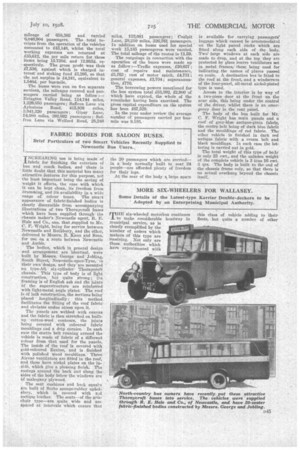FABRIC BODIES FOR SALOON BUSES.
Page 99

If you've noticed an error in this article please click here to report it so we can fix it.
Brief Particulars of two Smart Vehicles Recently Supplied to Newcastle Bus Users.,
T.NCREASING use is being made of JLfabric for -finishing the exteriors of bus -and coach bodies, and there is little doubt that this material has many attractive features for this purpose, not the least important being the saving of weight it effects the ease with which it can be kept Clean, its freedom from drumming, and its availability in a wide range of colour tones. The smart appearance of fabric-finished bodies is clearly discernible from accompanying Illustrations of two Thornyeroft buses which have been supplied through the chassis maker's Newcastle agent, R. E. Bale and Co., one, that supplied to Mr. C. F. Wright, being for service between Newcastle and Rothbury, and the other, delivered to Messrs. R. Knox and Sons, for use on a route between Newcastle and Amble.
The • bodies, which in general design and arrangement are identical, were built by Messrs. George and Jobling, South Street, Newedstle-upon-Tyne, to their own'design, and they are mounted on type-A6, six-cylinder Thornycroft chassis. This type of body is of light construction, but quite strong; Cee framing is of English ash and the joints of the superstructure are reinforced with light-metal angle plates. The roof is of lath construction, the sections being' placed ' longitudinalb'
, • this method facilitates the fitting of the roof fabric and obviates undue stress upon it.
The panels are webbed with canvas and the fabric is then stretched on built-: up cotton-wool contours, the joints being covered with coloured fabric Mouldings and a drip cornice. In each case the centre belt running around the vehicle is made of fabric of a different Colour from that used for the panels. The inside of the roof is covered with gold-coloured Rexine, and is finished With 'polished wood mouldings: Three Airvac ventilators are fitted in the roof, and these have nickel plates on the inside, which give a pleasing finish. The casings around the back and along the sides of the body below the windows are Of mahogany plyiveod.
The seat cushions and back squabs are built of Sorb° sponge:rubber upholstery, which is covered with rd antique leather. The seats—of the armchair type--are quite wide and are t3pfteed at intervals which ensure that
the 20 passengers which are carried— in a body normally built to seat 24 people—are afforded plenty of freedom for their legs.
At the rear of the body a large space
is available for carrying passengers' luggage which cannot be accommodated on the light parcel racks which are fitted along each side of the body. Two' large windows at each side are made to drop, and at the top they are Protected by glass louvre ventilators set in metal frames; these being used for indicating the names of places passed en route. A destination box is fitted to the roof at the front, and windscrem of the four-panel, all-metal nickel-plated type is used.
Access to the interior is by way of a two-piece door at the front on the near side, this being under the control of the driver, whilst there is an emergency door in the rear panel.
The body of the bus built for Mr. C. F. Wright has main panels and a roof of grey-blue antique-grain fabric, the centre belt being of dark blue fabric and the mouldings of red fabric. The other vehicle is finished in dark red antique fabric with a cream belt and black mouldings. In each case the letter-in.' is carried out in gold.
The total weight of this type of body is only 23 cwt., and the unladen weight of the complete vehicle is 3 tons 16 cwt 3 qrs. The body is built to the end of the chassis frame only, so that there is no actual overhang beyond the chassis itself.












































































































































































